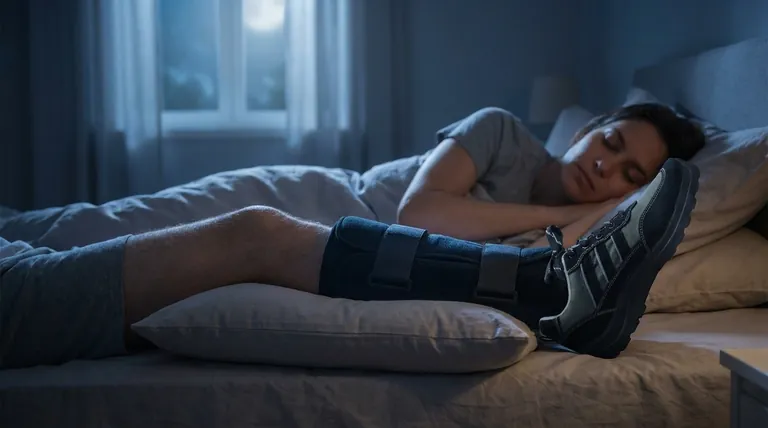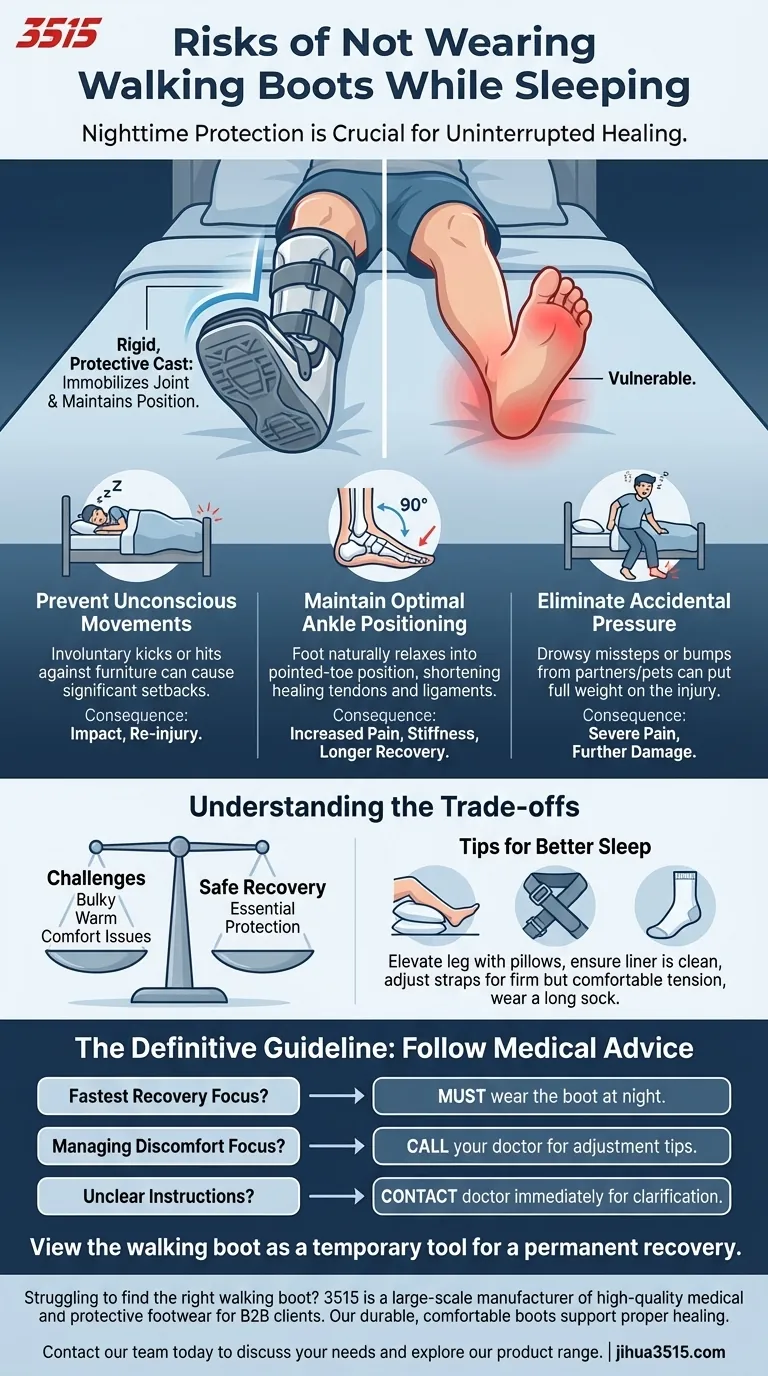For most injuries, you should wear your walking boot while sleeping if instructed by your doctor. Failing to do so exposes your injured limb to several risks, including unintentional kicking or hitting the foot, allowing the ankle to rest in a harmful extended position, and accidentally putting intense pressure on the injury if you move or get up while groggy.
The core purpose of a walking boot shifts at night. While it provides support for mobility during the day, its primary nighttime function is to act as a rigid, protective cast that immobilizes the joint and maintains optimal positioning, creating an uninterrupted healing environment while you are unconscious.

Why Nighttime Protection is Crucial for Healing
The hours you spend asleep are a critical period for tissue repair. However, this is also a time when you have no conscious control over your body, making your injured foot or ankle incredibly vulnerable without proper protection.
Preventing Unconscious Movements
During sleep, it's common to shift positions, twitch, or kick. Without the boot, a single involuntary movement can hit the injured area against a bedframe or wall, causing a significant setback to your recovery. The boot acts as a protective shell, absorbing these impacts.
Maintaining Optimal Ankle Positioning
Many injuries, particularly to the Achilles tendon or ankle ligaments, heal best when the foot is held in a neutral, 90-degree position. When you sleep without a boot, your foot naturally relaxes into a pointed-toe position (plantar flexion). This can cause healing tendons and ligaments to shorten and tighten overnight, leading to increased pain, stiffness, and a longer recovery time.
Eliminating Accidental Pressure
If you get up in the middle of the night, you may forget about your injury in your drowsy state and put your full weight on the foot. The boot makes this virtually impossible. It also shields the injury from accidental pressure if a partner, child, or pet bumps into your leg while you sleep.
Understanding the Trade-offs
Acknowledging the downsides of wearing a boot to bed is important. The goal is not to ignore the discomfort but to manage it while prioritizing a safe recovery.
The Challenge of Comfort
Walking boots are undeniably bulky, rigid, and can be warm. They can make finding a comfortable sleeping position difficult and may disrupt your normal sleep patterns, especially in the first few nights.
The Risk of Over-Tightening
Some people tighten the straps excessively, hoping to make the boot feel more secure. This can cut off circulation, cause numbness, or create painful pressure points. The straps should be snug enough to prevent movement but not uncomfortably tight.
Tips for Better Sleep
You can improve comfort by using pillows to elevate your leg, which can also help reduce swelling. Ensure the liner is clean and dry before bed. Adjust the straps to a firm but comfortable tension, and consider wearing a long sock to prevent the liner from irritating your skin.
The Definitive Guideline: Follow Medical Advice
While the principles of nighttime protection are clear, your doctor's instructions are the only definitive guide for your specific injury.
- If your primary focus is the fastest possible recovery: You must wear the boot at night if instructed, as it creates the ideal, stable environment for healing.
- If your primary focus is managing discomfort: Do not simply stop wearing the boot; instead, call your doctor to discuss the issue and ask for specific tips on adjusting it for sleep.
- If you were not given clear nighttime instructions: Contact your doctor for clarification immediately. Never assume it's safe to go without it.
Ultimately, viewing the walking boot as a temporary tool for a permanent recovery is the most effective mindset.
Summary Table:
| Risk of Not Wearing Boot | Consequence |
|---|---|
| Unconscious Movements | Kicking or hitting the injury, causing setbacks. |
| Poor Ankle Positioning | Tendons and ligaments tighten, increasing pain and stiffness. |
| Accidental Pressure | Putting full weight on the injury when groggy or being bumped. |
Struggling to find the right walking boot for your recovery? As a large-scale manufacturer, 3515 produces a comprehensive range of high-quality medical and protective footwear for distributors, brand owners, and bulk clients. Our production capabilities ensure durable, comfortable boots that support proper healing. Let us help you provide the best for your customers. Contact our team today to discuss your needs and explore our product range.
Visual Guide

Related Products
- Durable Rubber-Soled Utility Shoes for Wholesale & Custom Brand Manufacturing
- Premium Grain Leather Safety Boots for Bulk Supply
- Premium Wholesale Wheat Nubuck Safety Boot with Rapid Lacing System
- Customizable Anti-Smash Safety Boots for Wholesale & Private Label Manufacturing
- Custom Wholesale Leather Safety Boots Direct Factory Manufacturing
People Also Ask
- What are the main applications of vulcanized rubber? Unlock Durability for Tires, Footwear & More
- What makes rubber sole shoes an economical and practical choice? Unmatched Durability & All-Weather Value
- Which type of sole is better for premium sneakers and why? The Definitive Guide to Rubber Outsoles
- What are the benefits of rubber work shoes? Unbeatable Protection for Wet & Demanding Jobs
- What historical breakthrough in 1844 contributed to modern shoe sole manufacturing? The Vulcanization Revolution



















